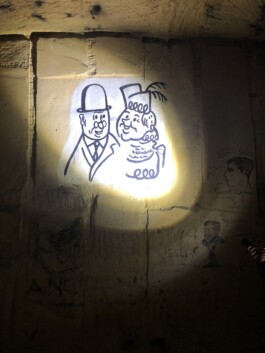Day Trip to Maastricht



Date
2023 November 23rd
Where three countries meet, unexpected art treasures are waiting to be discovered: in and around Maastricht, the Borderlanders not only visited renowned art institutions, but immersed themselves in secret underground worlds.
Welcome to the Jan van Eyck Academie
The Jan van Eyck Academie is one of the most prestigious postgraduate academies in the world. Every year, thousands of artists, designers, architects and creatives apply for one of the coveted residency places. And so the beautiful, historic city on the Meuse, which lies in the direct neighbourhood of Belgium and Germany, becomes a hub for international encounters between artists. For the third time, the academy opened its doors to the Borderland artists, who were able to get to know the institution better in conversation with Bruno Alves de Almeida, curator and head of the residency programme.



Hidden underground... worlds open up
After the Borderlanders had spent the morning in the bright rooms of the academy, flooded with light through the high glass windows, the afternoon had an obscurity in store for them. The Cannerberg is just a 10-minute drive from the centre of Maastricht. The small, wooded hill is a popular recreational area for the people of Maastricht, whose peaceful appearance belies its turbulent history.
For centuries, sandstone was quarried in the Cannerberg, which still paves the city's streets and buildings today. Over the course of time, a labyrinthine tunnel system was created that stretches some 35 kilometres underground. For the people of Maastricht, the quarry was part of their everyday living and working environment - but for one particular group of the city's inhabitants, mining held a special fascination: From 1860, monks from the Jesuit monastery located in Maastricht became regular guests underground - and that's how it happened: Six days a week, the Jesuit monks devoted themselves to their work and duties in the monastery. But one day a week was dedicated to secular education. Every Wednesday, the monks were encouraged to go out of the monastery and into the world. As a secular education and adventure programme, so to speak. In other words, it was their day off.



What motivated the monks to go to the quarry on their day off remains their secret. But that's exactly what happened. From around 1860, a group of monks began to spend their Wednesdays in the long, dark corridors of the quarry. There, they not only made friends with the miners, but also discovered a very special treasure in the quarry's tunnel system: kilometres of sandstone walls, which from then on served as their canvases.
For a good hundred years, the monks painted the walls of the tunnel system with a wide variety of motifs: from replicas of famous sacred art and comic motifs to replicas of important architectural history, such as a room modelled on the Alhambra or 3D models of their countries of origin. The tunnels of the Cannerberg, which is also known today as the Jesuit Mountain, have plenty to offer. In addition to numerous murals, they also carved chancels and dining rooms into the sandstone, which are still used today for baptisms, weddings and private celebrations.
The monks used the quarry as their Wednesday outpost until the 1950s, before a new "tenant" moved into the Cannerberg: in 1954, NATO was granted the right to use the tunnel system, where they set up a communications centre and headquarters, which operated there until the end of the Cold War in 1992.